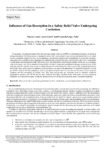Mostrar o rexistro simple do ítem
Influence of Gas Desorption in a Safety Relief Valve Undergoing Cavitation
| dc.contributor.author | Lema, Marcos | |
| dc.contributor.author | Gosset, Anne | |
| dc.contributor.author | López Peña, Fernando | |
| dc.date.accessioned | 2024-01-31T15:08:52Z | |
| dc.date.issued | 2019-12-27 | |
| dc.identifier.citation | LEMA, Marcos, GOSSET, Anne and PEÑA, Fernando López, 2019. Influence of Gas Desorption in a Safety Relief Valve Undergoing Cavitation. International Journal of Fluid Machinery and Systems. Online. December 2019. Vol. 12, no. 4, p. 451–458. DOI 10.5293/IJFMS.2019.12.4.451 | es_ES |
| dc.identifier.issn | 1882-9554 | |
| dc.identifier.uri | http://hdl.handle.net/2183/35283 | |
| dc.description.abstract | [Abstract]: In this study, the characterization of the flow through a safety relief valve (SRV) is performed in presence of cavitation and gas desorption. For this purpose, a transparent safety relief valve model is used on an experimental facility in which the flow conditions (mass flow rate, fluid temperature, and pressure upstream and downstream the valve) are accurately monitored. For six different valve openings, the characteristic curves of the valve are measured while flow visualization is performed on the transparent model. The results show that choked flow conditions are reached for the six valve openings used in this study, and with a remarkable repeatability. In order to take into consideration the gas saturation level of the working fluid, the vacuum system used to adjust the pressure downstream the valve is also used for gas desorption by storing the liquid under vacuum conditions, a process known as vacuum degasification. In saturated liquids the evolved gas bubbles modify the flow properties, such as the speed of sound, and this may have an influence in the cavitation inception and the occurrence of choked flow. This study proves that gas saturated water in standard conditions (atmospheric pressure and 293 K) has the same behavior that fully deaerated water, both under the same cavitating conditions. It is thus not necessary to take the saturation level of the liquid into account when in standard conditions. | es_ES |
| dc.language.iso | eng | es_ES |
| dc.publisher | Korean Society for Fluid Machinery (KSFM), Chinese Society of Engineering Thermophysics (CSET), Turbomachinery Society of Japan (TSJ), IAHR Section on Hydraulic Machinery and Systems (IAHR) | es_ES |
| dc.relation.uri | http://dx.doi.org/10.5293/IJFMS.2019.12.4.451 | es_ES |
| dc.subject | Safety relief valve | es_ES |
| dc.subject | Cavitation | es_ES |
| dc.subject | Gas desorption | es_ES |
| dc.subject | Flow visualization | es_ES |
| dc.subject | Vacuum degasification | es_ES |
| dc.subject | Choked flow | es_ES |
| dc.title | Influence of Gas Desorption in a Safety Relief Valve Undergoing Cavitation | es_ES |
| dc.type | info:eu-repo/semantics/article | es_ES |
| dc.rights.access | info:eu-repo/semantics/embargoedAccess | es_ES |
| dc.date.embargoEndDate | 9999-99-99 | es_ES |
| dc.date.embargoLift | 10007-06-07 | |
| UDC.journalTitle | International Journal of Fluid Machinery and Systems | es_ES |
| UDC.volume | 12 | es_ES |
| UDC.issue | 4 | es_ES |
| UDC.startPage | 451 | es_ES |
| UDC.endPage | 458 | es_ES |
Ficheiros no ítem
Este ítem aparece na(s) seguinte(s) colección(s)
-
GII-Artigos [19]






